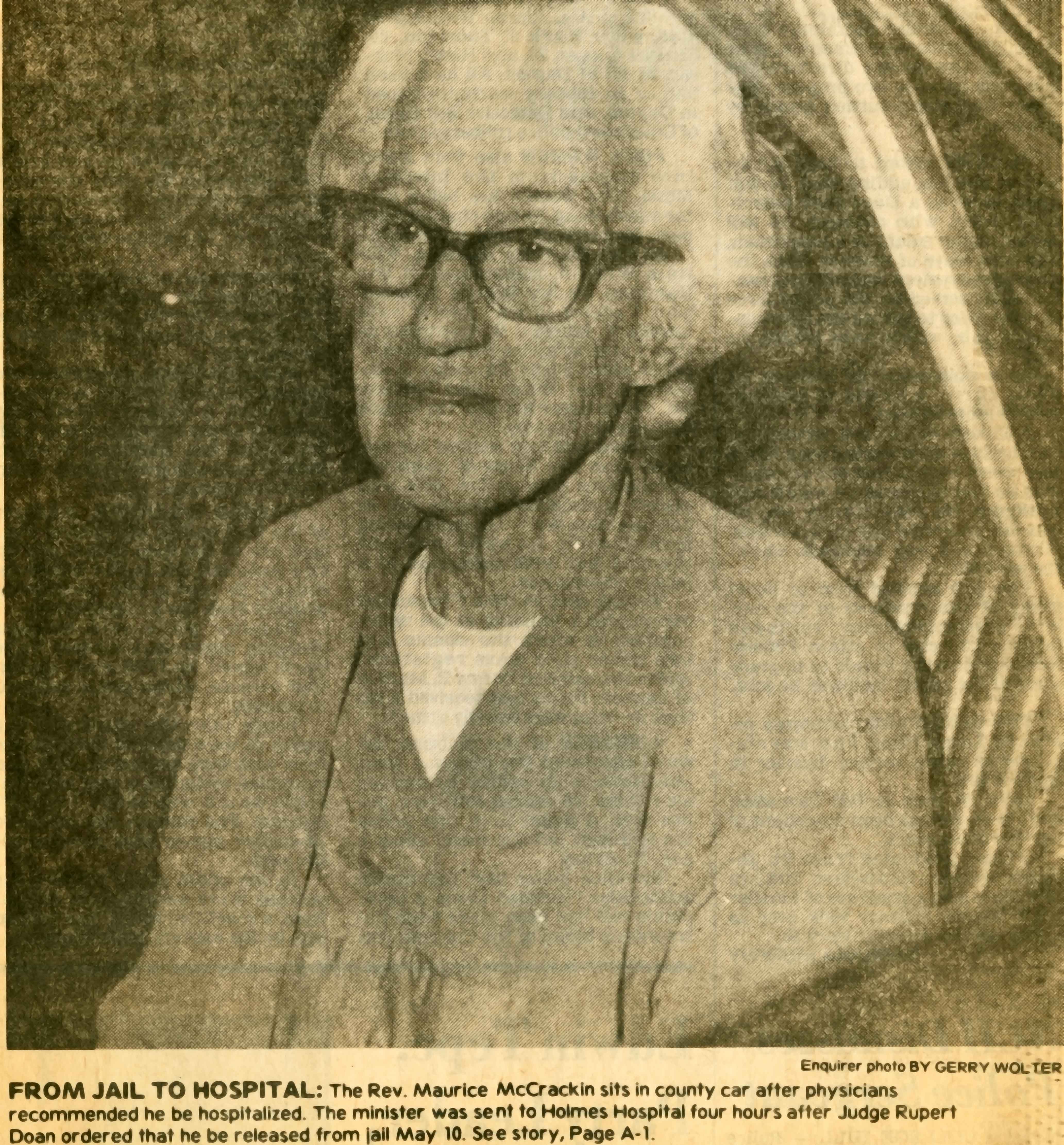By: Nathan Hood
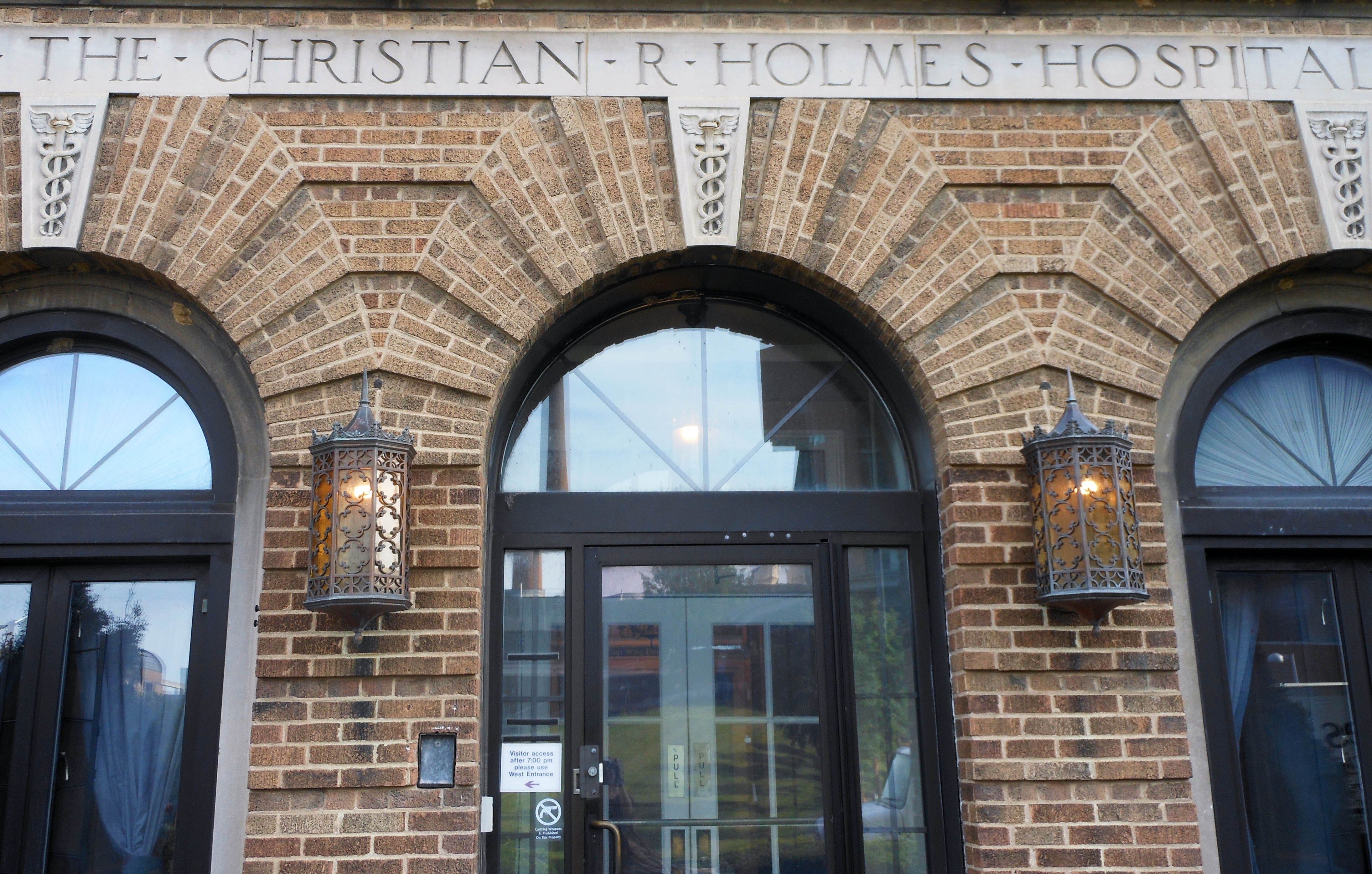
Christian R. Holmes Hospital,
opened May of 1929.
This photo serves as a link to the Winkler Center blog, “The Origin and Evolution of The Christian R. Holmes Hospital.”
The Christian R. Holmes Hospital opened in May of 1929, but it wasn’t until the University of Cincinnati’s proposal process for a new Holmes Hospital Auxiliary building that any serious controversy arose over the Holmes Hospital’s modern function. As has been enumerated before, from the time of its opening the Holmes Hospital was intended to function as a private institution exclusively utilized by the College of Medicine faculty. The Hospital has long since been converted to an extension of the University Hospital; but its history, even still contentious today, is definitely worth understanding because of its pivotal role in sculpting the University medical institution Cincinnati knows today.
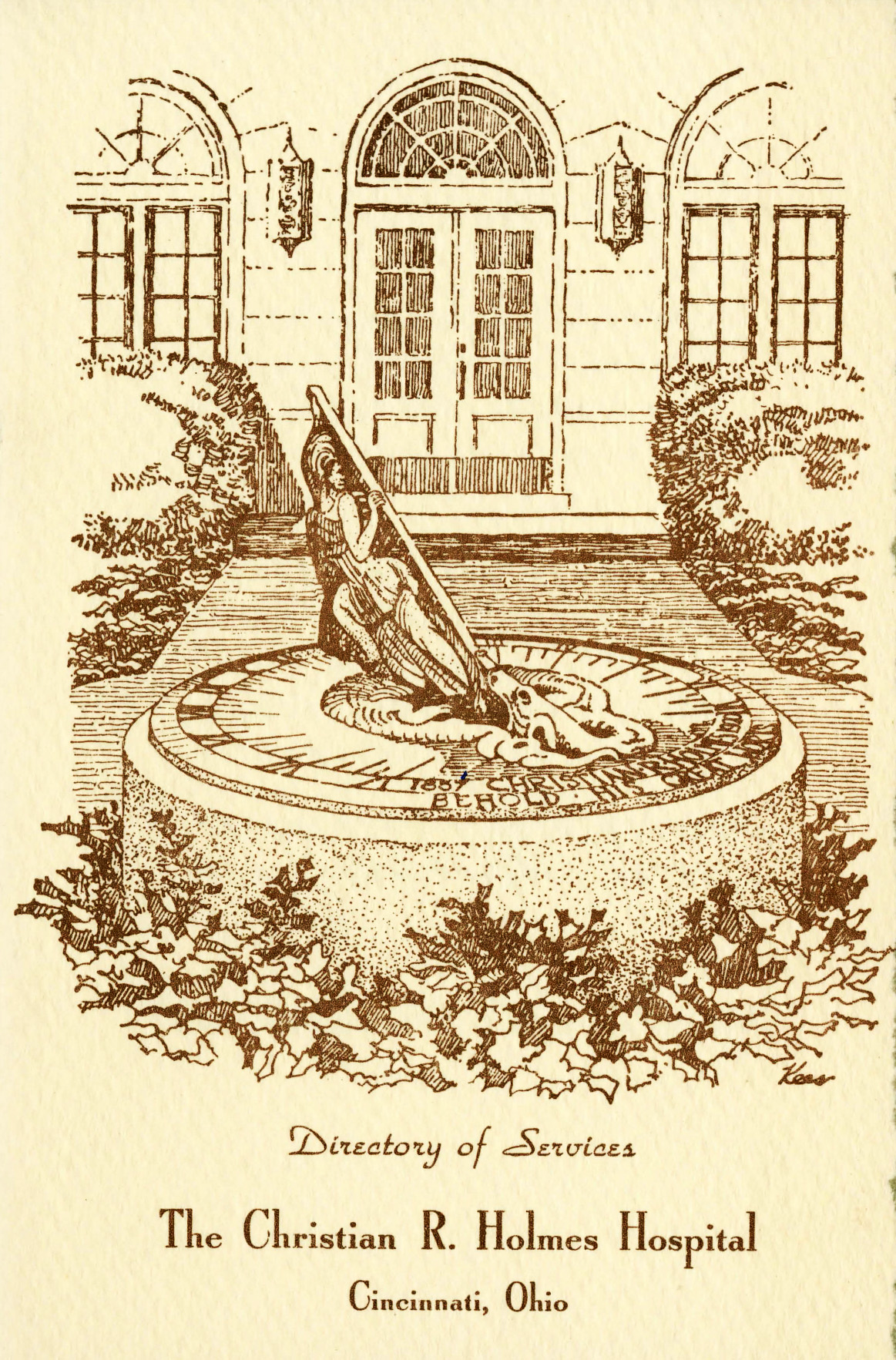
Directory of Services for the Christian R. Holmes Hospital
Undated
Box 1 Folder 4, Christian R. Holmes Hospital Collection
This photo serves as a link to a digital copy of the entire document.
Since its opening but before even the thought of an auxiliary building, there were certainly other renovation and additions to the Holmes Hospital: In 1960, the “Tate Wing” raised the total patient capacity to sixty-seven; In 1961, an enlarged Operating Suite was opened on the fifth floor; around 1962 the fourth floor was remodeled raising this total again, to eighty-three; in 1970 several more beds were added making the total eighty-seven; In 1973, an ICU unit of three beds was opened. The general trend obviously being the growth and expansion of the hospital. Unfortunately however, by the mid-to-late 70’s the Holmes and General Hospitals were struggling to accommodate patients in Cincinnati.
The University’s proposal for the ‘west wing,’ axillary extension of the Holmes Hospital was so ambitiously substantial that it cannot really compare to the size, scope and significance of Holmes Hospital’s other comparably minor projects. In order to secure funds from the Ohio government, the University of Cincinnati needed the approval of the Health Planning and Resource Development Association of the Central Ohio River Valley (CORVA). The federal government had only just recently “established CORVA as the area’s health systems agency in 1977.” It was a kind of board “made up of 30 health professionals and consumers from eight Southwestern Ohio counties and three Northern Kentucky counties.” Around this time, CORVA was struggling to obtain an accurate and reliable account of the number and dispersion of patient beds in the surrounding area so that they could more properly allocate federal funds to communities that need them most. At that moment it was loosely thought there was surplus of patient beds and because there was a lack of decent information, in 1978 CORVA “voted 16-8 to stop approving additions or renovations (increasing the number of patient beds) until a consultant recommended where beds should go and where they should be eliminated.”
CORVA’s moratorium became one of the major obstacles of the University of Cincinnati’s Holmes Hospital expansion project. However, in April of 1979 CORVA proved the moratorium could be overlooked when they approved two other projects unrelated to the University “involving renovation or intensive care beds for ‘patient safety.’”
It is likely no coincidence then that In May 4, 1979 the “UC board of trustees approved bylaws for a University Hospital with a General and a Holmes division” – this was expected to strengthen their funding proposal to CORVA by suggesting the hospitals’ intended future cooperation as a more singular institution. Around this time as well, the “‘Holmes and General [Hospitals] were accredited … as one institution … but for only one year.’” Truly, whether these bylaws were a sincere indication of the Hospital’s intentions or some kind of superficial political promise was and still remains unclear. Even then the expansion project was receiving both internal and external opposition. The Holmes Hospital had been a private institution juxtaposed with the General Hospital for so long that it had become a part of Cincinnati’s socio-politics.
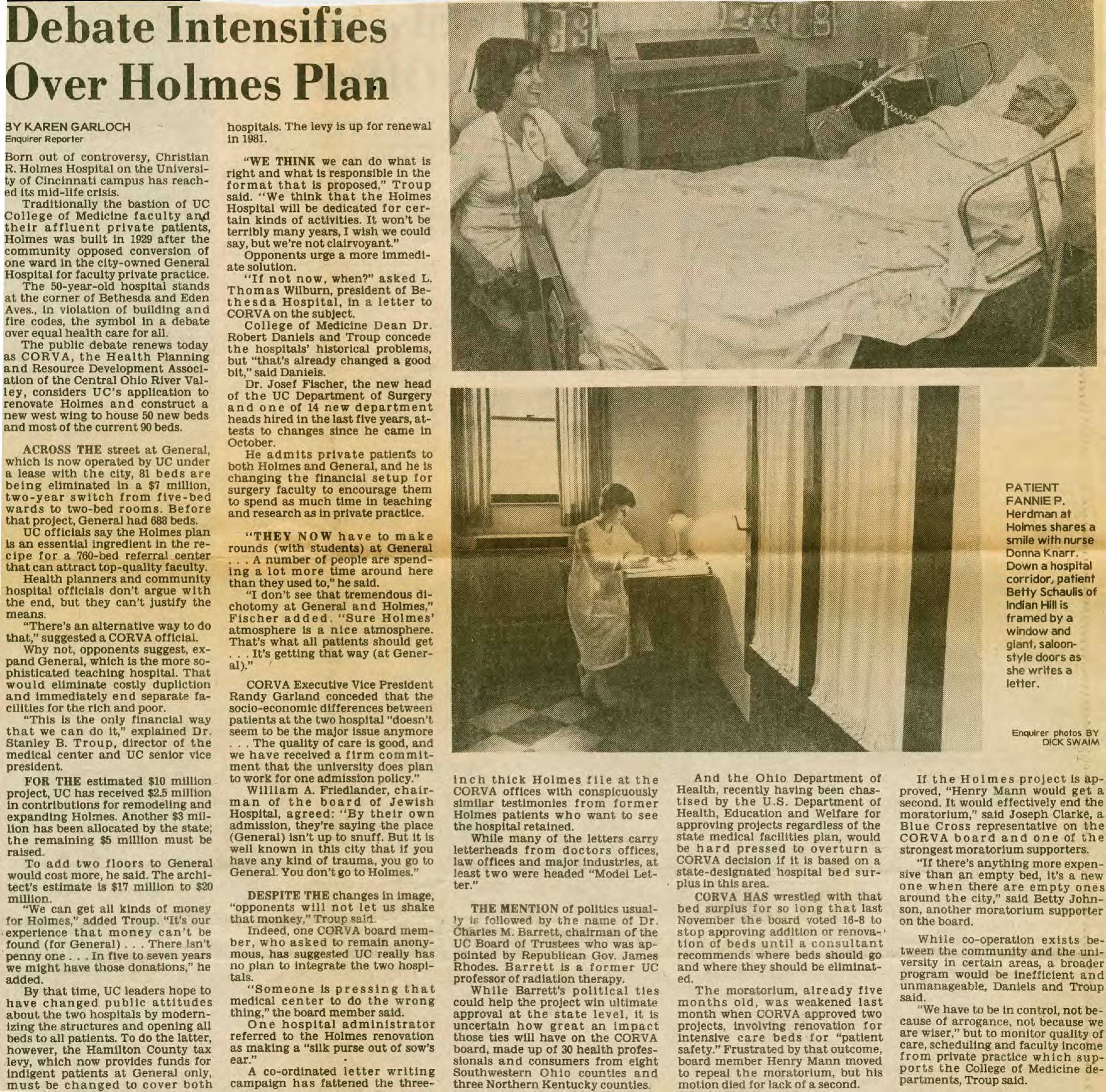
“Debate Intensifies Over Holmes Plan”, Cincinnati Enquirer, May 7, 1979
Box 1 Folder 11, Christian R. Holmes Hospital Collection
At the time, the general public’s thought was that those hospitalized at the Holmes Hospital were more than likely of the wealthy upper-class; those hospitalized at the General Hospital, more generally un-wealthy or lower-class. It appears that this perspective was not entirely unjustified; indeed, the difference in logistics and patient care between the two was no secret to the community. Despite the University’s official efforts to express the new cohesion of these two ironically-named “divisions,” the public still perceived them as two separate and unequal entities. Those opposing the expansion felt that it would perpetuate the concept of unequal healthcare.
Regardless, around May 7th, the Hamilton County unit of CORVA – CORVA’s Central Subarea Council (HAMCO) – soon after voted in favor of the University’s proposal, 13 to 6. This was presumably and understandably a rather inflammatory decision.
To complicate perceptions of the University Hospital, the Holmes Division was receiving media attention for treating the incarcerated Reverend Maurice McCrackin. The Reverend was spending the last days of his jail sentence recovering from the effects of his self-imposed and intense fasting exercises in prison. Though incarcerated, it seems Rev. McCrackin was loosely perceived as a kind of modern martyr and looked upon favorably by many in the Cincinnati community. The legal case and its slight association with the Holmes Hospital/Division very probably exacerbated the growing controversy surrounding the University Hospital and may have even introduced religion as a factor in community discussion
Around May 15, a “CORVA proposal review committee voted down the Holmes expansion project 11 to 7 after asking many questions.” The deciding a crucial vote from CORVA’s board of trustees was scheduled for that Thursday evening, May 17. However, the University instead chose to employ their right to ask for an extension. This happened on May 16 just hours before CORVA’s trustees were to vote. Much to the chagrin of some board members, the University successfully received a 30-day extension; but not before a dissenting board member, Roberta Grant, made an ominous reminder:
“[Today, May 17,] is the anniversary of the Supreme Court decision that separate but equal is not inherently equal’”
The Ohio Department of Health finally approved funds in July of 1979. The construction contract was signed in May of 1980. When the construction was completed and the University began the process of furnishing the auxiliary building, the cost of the project had already exceeded the $9.3 million estimate decided in 1979.
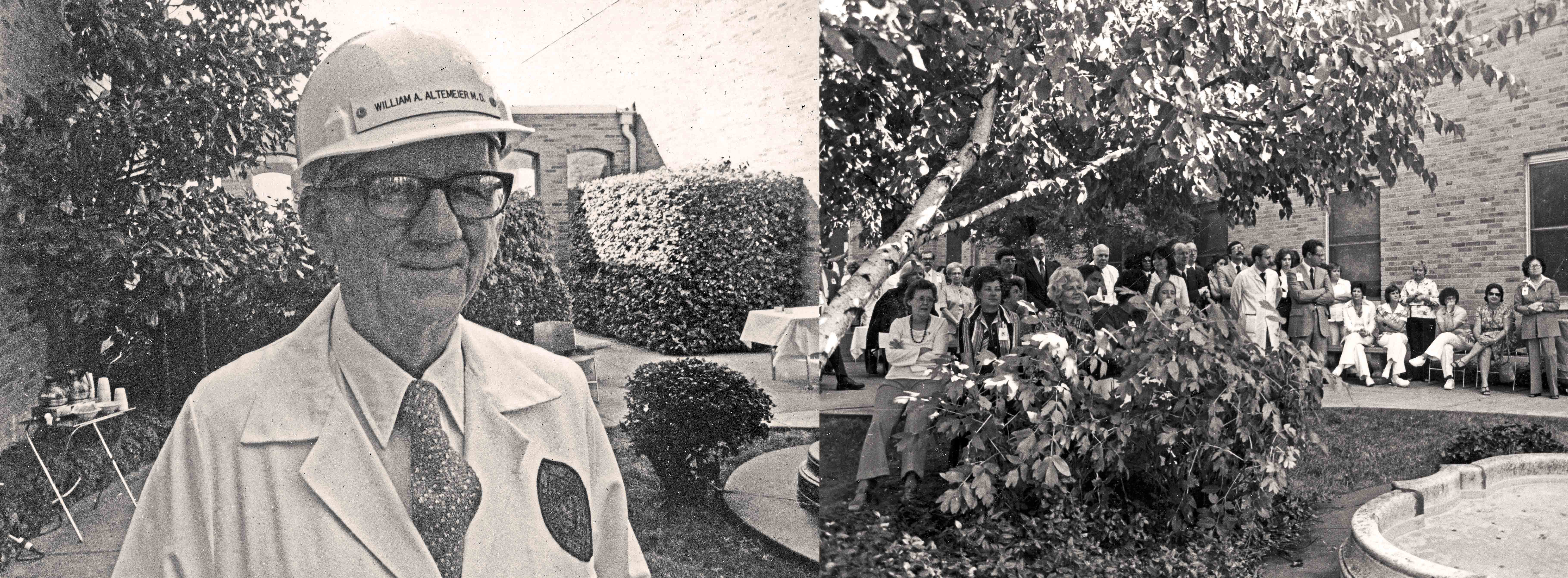
Reception to Celebrate Construction of New Wing, 1980
Pictured left, Dr. William A. Altemeier
Box 1 Folder 8, Christian R. Holmes Hospital Collection
This photo serves as a link to the Winkler Center blog, “From the Archives: William A. Altemeier, MD Collection Discovery.”
Sometime between 1979 and August 1982, the University submitted a second proposal to drastically increase the total amount of funds for the project to a massive $11.1 million. This was obviously not received well by those CORVA board members who had disagreed with the University’s original allocation of funds in 1979. Hospitals’ exceeding their cost estimates for construction though, was not an uncommon occurrence. Quite the opposite, it apparently happened so frequently that it was considered by more than several to be dubious. Nevertheless, to finish the hospital, the proposal was inevitably approved.
In the University’s defense, Hospital Administrator Hirsch J. Cohen publically claimed that the delay between writing the proposal and approval for funds (approximately 1.5 years) was at least part of the reason for the increase in expenses. Very simply, the cost of materials apparently increased over time. Advances in medical technology, standards in medical care, and other reasons were also implicated as evidence for the Holmes Division’s expensiveness.
The Holmes Division’s new wing opened for patients on August 14, 1982, and was officially dedicated on July 10, 1982. This building contained numerous improvements:
“The New Wing contains two floors of spacious patient accommodations; new surgical suites of the most modern architectural design, latest equipment, and traffic control, five pre-anesthesia holding rooms and seven post-anaesthesia [post-anesthesia] recovery rooms; a new surgical family consultation and waiting room; intensive care and coronary care units; laboratories and radiologic facilities; cafeteria; and administrative and other support areas.” (From Cincinnati Horizons, “Holmes Hospital Division’s New Wing,” October 1982.)
“…six-floor wing has 40 single and 14 double patient rooms; four operating suites with a central sterile processing area; a five- to seven-bed special care unit with the latest cardiac monitoring, diagnostic, and life-support equipment; and a surgical pathology – frozen section laboratory…” (From records of the Holmes Division’s dedication.)

Dr. Christian R. Holmes. This photo serves as a link to the Winkler Center blog, “Dr. Christian R. Holmes, The Cincinnati General Hospital, and the Surgical Amphitheater.”
A special thanks to Veronica Buchanan for her contemporary photographs of the UC Health Holmes Hospital. Many thanks as well to Dr. Fischer and others for documenting history that otherwise would have been lost.
It must be noted that a very large majority of the information above was collected and established through various newspaper records and University materials – both naturally expressing variously different biases and opinions regarding the particularly querulous events of this time period. While this article attempts to remain fairly factual, it is important to consider the reality that its sources were understandably and unavoidably questionable. They were, indeed, some of the only sources of information on the topic.
For more information, to view a collection, or for a tour of The Winkler Center, please call 558-5120 or email chhp@uc.edu to schedule an appointment.

